sensor MERCEDES-BENZ CL-Class 2012 C216 Owner's Manual
[x] Cancel search | Manufacturer: MERCEDES-BENZ, Model Year: 2012, Model line: CL-Class, Model: MERCEDES-BENZ CL-Class 2012 C216Pages: 488, PDF Size: 21.88 MB
Page 9 of 488
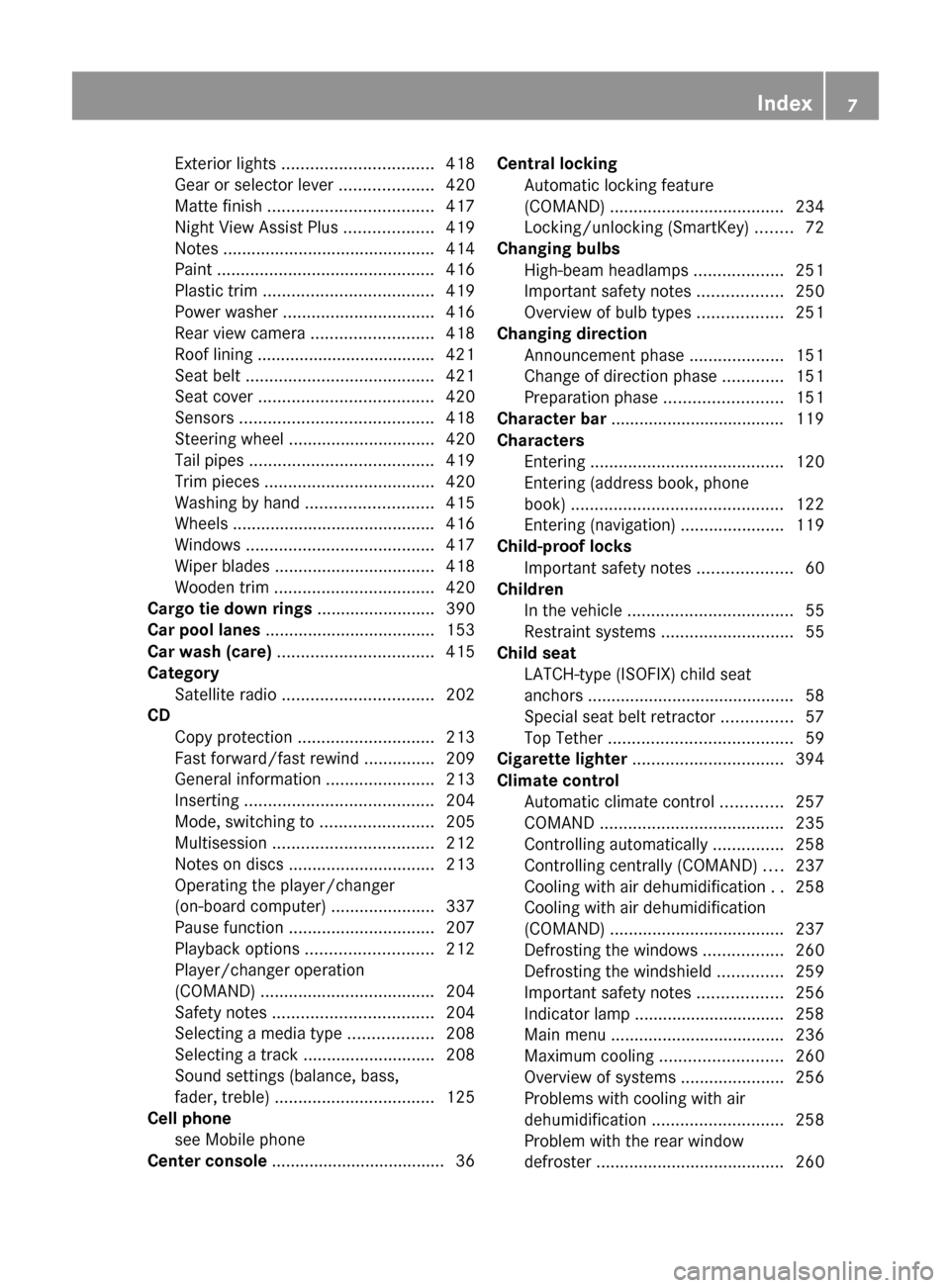
Exterior lights ................................ 418
Gear or selector lever ....................420
Matte finish ................................... 417
Night View Assist Plus ...................419
Notes ............................................. 414
Paint .............................................. 416
Plastic trim .................................... 419
Power washer ................................ 416
Rear view camera .......................... 418
Roof lining ...................................... 421
Seat belt ........................................ 421
Seat cover ..................................... 420
Sensors ......................................... 418
Steering wheel ............................... 420
Tail pipes ....................................... 419
Trim pieces .................................... 420
Washing by hand ........................... 415
Wheels ........................................... 416
Windows ........................................ 417
Wiper blades .................................. 418
Wooden trim .................................. 420
Cargo tie down rings ......................... 390
Car pool lanes .................................... 153
Car wash (care) ................................. 415
Category Satellite radio ................................ 202
CD
Copy protection ............................. 213
Fast forward/fast rewind ...............209
General information .......................213
Inserting ........................................ 204
Mode, switching to ........................205
Multisession .................................. 212
Notes on discs ............................... 213
Operating the player/changer
(on-board computer) ......................337
Pause function ............................... 207
Playback options ........................... 212
Player/changer operation
(COMAND) ..................................... 204
Safety notes .................................. 204
Selecting a media type ..................208
Selecting a track ............................ 208
Sound settings (balance, bass,
fader, treble) .................................. 125
Cell phone
see Mobile phone
Center console ..................................... 36Central locking
Automatic locking feature
(COMAND) ..................................... 234
Locking/unlocking (SmartKey) ........72
Changing bulbs
High-beam headlamps ...................251
Important safety notes ..................250
Overview of bulb types ..................251
Changing direction
Announcement phase ....................151
Change of direction phase .............151
Preparation phase .........................151
Character bar ..................................... 119
Characters Entering ......................................... 120
Entering (address book, phone
book) ............................................. 122
Entering (navigation) ......................119
Child-proof locks
Important safety notes ....................60
Children
In the vehicle ................................... 55
Restraint systems ............................ 55
Child seat
LATCH-type (ISOFIX) child seat
anchors ............................................ 58
Special seat belt retractor ...............57
Top Tether ....................................... 59
Cigarette lighter ................................ 394
Climate control Automatic climate control .............257
COMAND ....................................... 235
Controlling automatically ...............258
Controlling centrally (COMAND) ....237
Cooling with air dehumidification ..258
Cooling with air dehumidification
(COMAND) ..................................... 237
Defrosting the windows .................260
Defrosting the windshield ..............259
Important safety notes ..................256
Indicator lamp ................................ 258
Main menu ..................................... 236
Maximum cooling .......................... 260
Overview of systems ......................256
Problems with cooling with air
dehumidification ............................ 258
Problem with the rear window
defroster ........................................ 260Index7
Page 16 of 488
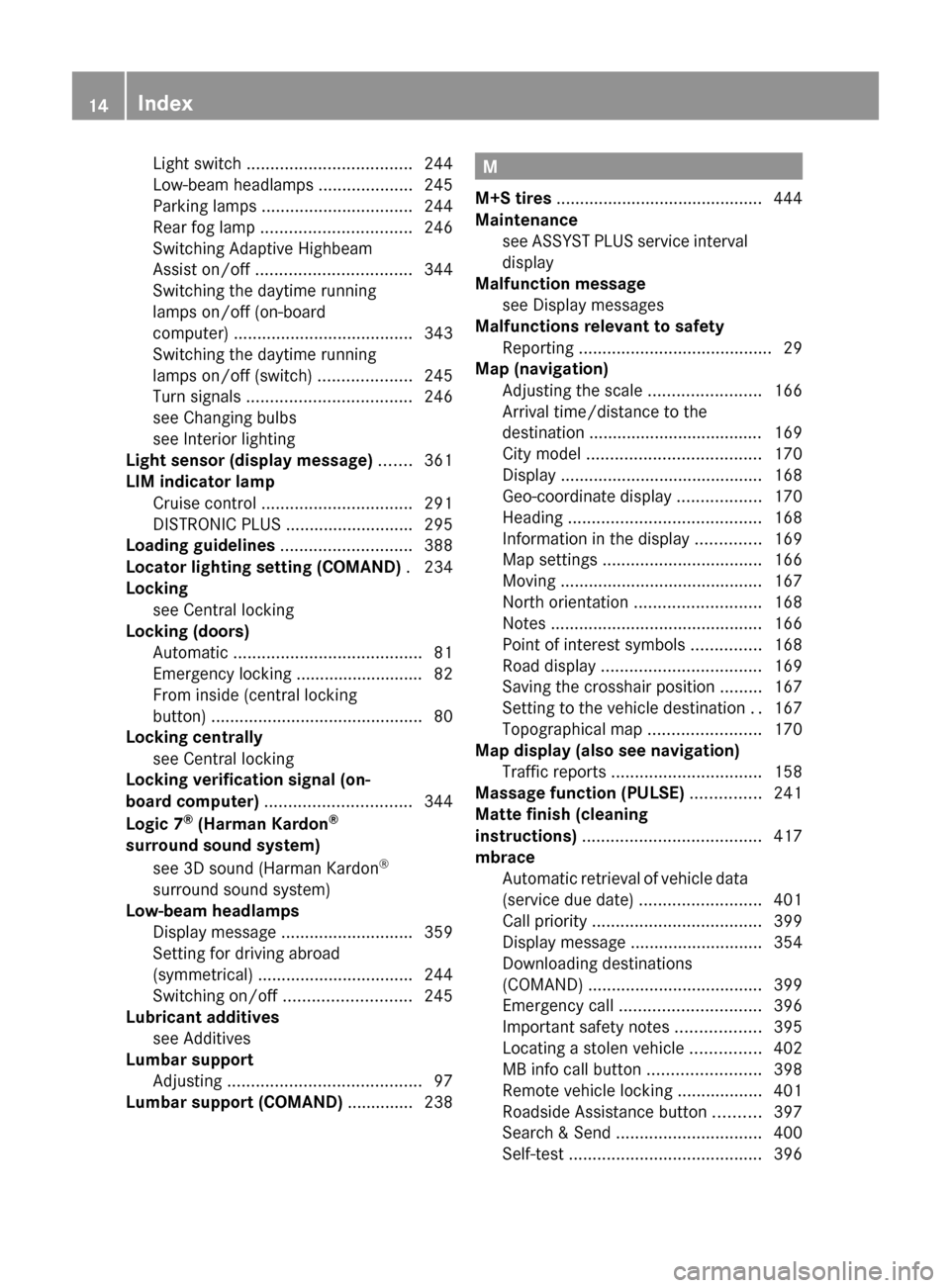
Light switch ................................... 244
Low-beam headlamps ....................245
Parking lamps ................................ 244
Rear fog lamp ................................ 246
Switching Adaptive Highbeam
Assist on/off ................................. 344
Switching the daytime running
lamps on/off (on-board
computer) ...................................... 343
Switching the daytime running
lamps on/off (switch) ....................245
Turn signals ................................... 246
see Changing bulbs
see Interior lighting
Light sensor (display message) ....... 361
LIM indicator lamp Cruise control ................................ 291
DISTRONIC PLUS ........................... 295
Loading guidelines ............................ 388
Locator lighting setting (COMAND) . 234
Locking see Central locking
Locking (doors)
Automatic ........................................ 81
Emergency locking ........................... 82
From inside (central locking
button) ............................................. 80
Locking centrally
see Central locking
Locking verification signal (on-
board computer) ............................... 344
Logic 7 ®
(Harman Kardon ®
surround sound system) see 3D sound (Harman Kardon ®
surround sound system)
Low-beam headlamps
Display message ............................ 359
Setting for driving abroad
(symmetrical) ................................. 244
Switching on/off ........................... 245
Lubricant additives
see Additives
Lumbar support
Adjusting ......................................... 97
Lumbar support (COMAND) .............. 238M
M+S tires ............................................ 444
Maintenance see ASSYST PLUS service interval
display
Malfunction message
see Display messages
Malfunctions relevant to safety
Reporting ......................................... 29
Map (navigation)
Adjusting the scale ........................166
Arrival time/distance to the
destination ..................................... 169
City model ..................................... 170
Display ........................................... 168
Geo-coordinate display ..................170
Heading ......................................... 168
Information in the display ..............169
Map settings .................................. 166
Moving ........................................... 167
North orientation ........................... 168
Notes ............................................. 166
Point of interest symbols ...............168
Road display .................................. 169
Saving the crosshair position .........167
Setting to the vehicle destination ..167
Topographical map ........................170
Map display (also see navigation)
Traffic reports ................................ 158
Massage function (PULSE) ............... 241
Matte finish (cleaning
instructions) ...................................... 417
mbrace Automatic retrieval of vehicle data
(service due date) ..........................401
Call priority .................................... 399
Display message ............................ 354
Downloading destinations
(COMAND) ..................................... 399
Emergency call .............................. 396
Important safety notes ..................395
Locating a stolen vehicle ...............402
MB info call button ........................398
Remote vehicle locking ..................401
Roadside Assistance button ..........397
Search & Send ............................... 400
Self-test ......................................... 39614Index
Page 19 of 488
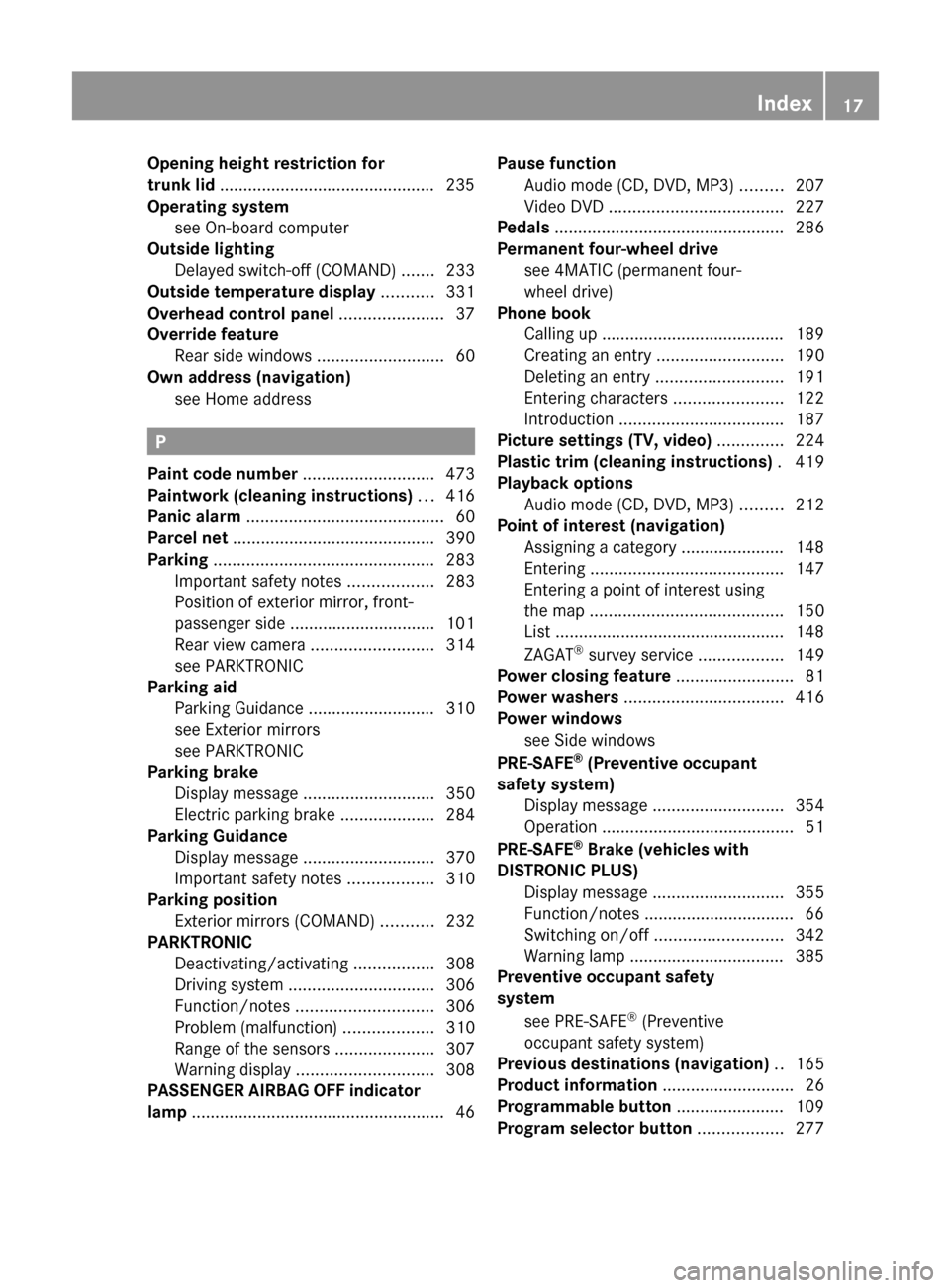
Opening height restriction for
trunk lid .............................................. 235
Operating system see On-board computer
Outside lighting
Delayed switch-off (COMAND) .......233
Outside temperature display ........... 331
Overhead control panel ...................... 37
Override feature Rear side windows ...........................60
Own address (navigation)
see Home address
P
Paint code number ............................ 473
Paintwork (cleaning instructions) ... 416
Panic alarm .......................................... 60
Parcel net ........................................... 390
Parking ............................................... 283
Important safety notes ..................283
Position of exterior mirror, front-
passenger side ............................... 101
Rear view camera .......................... 314
see PARKTRONIC
Parking aid
Parking Guidance ........................... 310
see Exterior mirrors
see PARKTRONIC
Parking brake
Display message ............................ 350
Electric parking brake ....................284
Parking Guidance
Display message ............................ 370
Important safety notes ..................310
Parking position
Exterior mirrors (COMAND) ...........232
PARKTRONIC
Deactivating/activating .................308
Driving system ............................... 306
Function/notes ............................. 306
Problem (malfunction) ...................310
Range of the sensors .....................307
Warning display ............................. 308
PASSENGER AIRBAG OFF indicator
lamp ...................................................... 46
Pause function
Audio mode (CD, DVD, MP3) .........207
Video DVD ..................................... 227
Pedals ................................................. 286
Permanent four-wheel drive see 4MATIC (permanent four-
wheel drive)
Phone book
Calling up ....................................... 189
Creating an entry ........................... 190
Deleting an entry ........................... 191
Entering characters .......................122
Introduction ................................... 187
Picture settings (TV, video) .............. 224
Plastic trim (cleaning instructions) . 419
Playback options Audio mode (CD, DVD, MP3) .........212
Point of interest (navigation)
Assigning a category ...................... 148
Entering ......................................... 147
Entering a point of interest using
the map ......................................... 150
List ................................................. 148
ZAGAT ®
survey service ..................149
Power closing feature ......................... 81
Power washers .................................. 416
Power windows see Side windows
PRE-SAFE ®
(Preventive occupant
safety system) Display message ............................ 354
Operation ......................................... 51
PRE-SAFE ®
Brake (vehicles with
DISTRONIC PLUS) Display message ............................ 355
Function/notes ................................ 66
Switching on/off ........................... 342
Warning lamp ................................. 385
Preventive occupant safety
system
see PRE-SAFE ®
(Preventive
occupant safety system)
Previous destinations (navigation) .. 165
Product information ............................ 26
Programmable button ....................... 109
Program selector button .................. 277Index17
Page 20 of 488
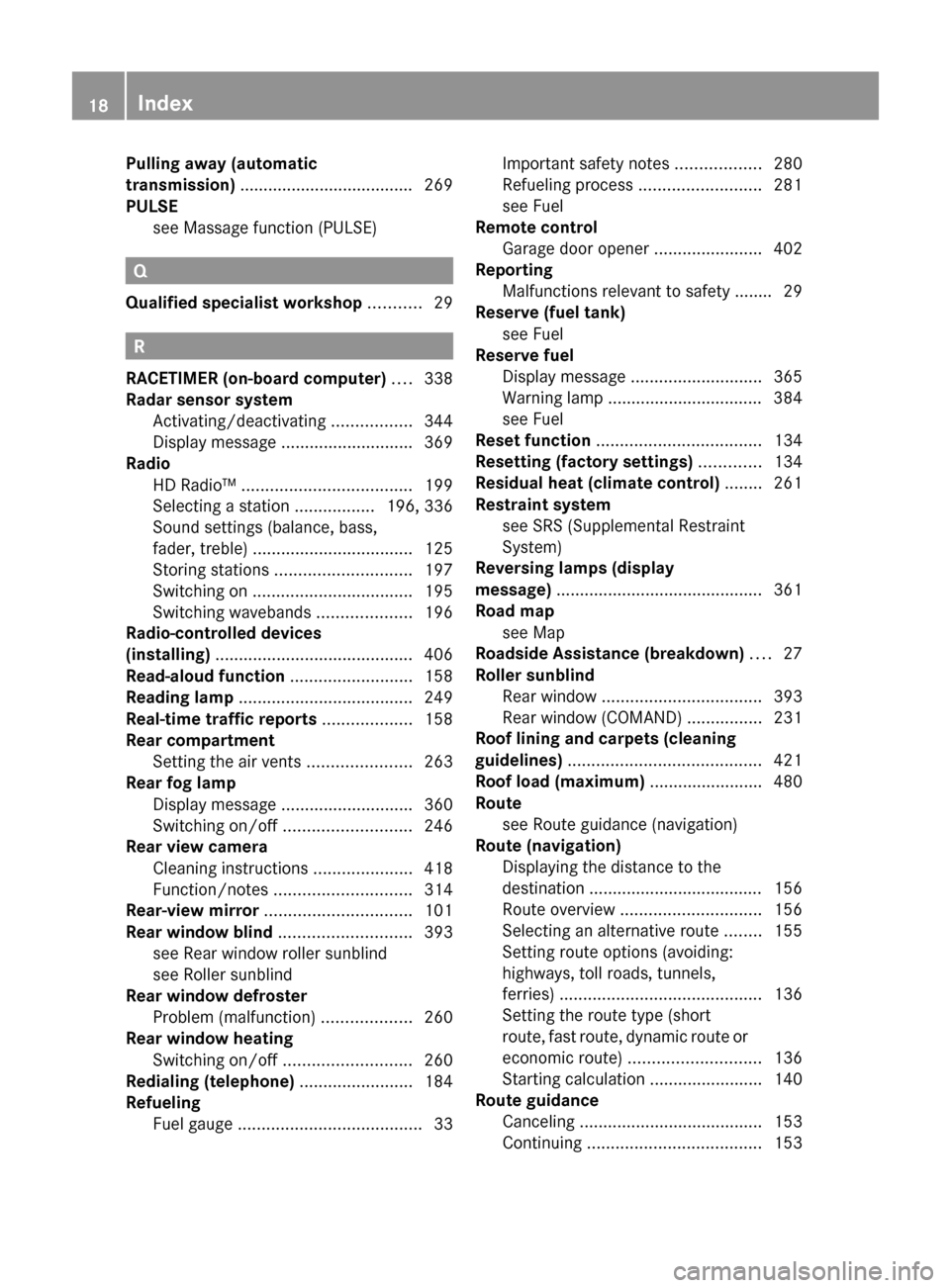
Pulling away (automatic
transmission) ..................................... 269
PULSE see Massage function (PULSE)
Q
Qualified specialist workshop ........... 29
R
RACETIMER (on-board computer) .... 338
Radar sensor system Activating/deactivating .................344
Display message ............................ 369
Radio
HD Radio™ .................................... 199
Selecting a station .................196, 336
Sound settings (balance, bass,
fader, treble) .................................. 125
Storing stations ............................. 197
Switching on .................................. 195
Switching wavebands ....................196
Radio-controlled devices
(installing) .......................................... 406
Read-aloud function .......................... 158
Reading lamp ..................................... 249
Real-time traffic reports ................... 158
Rear compartment Setting the air vents ......................263
Rear fog lamp
Display message ............................ 360
Switching on/off ........................... 246
Rear view camera
Cleaning instructions .....................418
Function/notes ............................. 314
Rear-view mirror ............................... 101
Rear window blind ............................ 393
see Rear window roller sunblind
see Roller sunblind
Rear window defroster
Problem (malfunction) ...................260
Rear window heating
Switching on/off ........................... 260
Redialing (telephone) ........................ 184
Refueling Fuel gauge ....................................... 33
Important safety notes ..................280
Refueling process ..........................281
see Fuel
Remote control
Garage door opener .......................402
Reporting
Malfunctions relevant to safety ........ 29
Reserve (fuel tank)
see Fuel
Reserve fuel
Display message ............................ 365
Warning lamp ................................. 384
see Fuel
Reset function ................................... 134
Resetting (factory settings) ............. 134
Residual heat (climate control) ........ 261
Restraint system see SRS (Supplemental Restraint
System)
Reversing lamps (display
message) ............................................ 361
Road map see Map
Roadside Assistance (breakdown) .... 27
Roller sunblind Rear window .................................. 393
Rear window (COMAND) ................231
Roof lining and carpets (cleaning
guidelines) ......................................... 421
Roof load (maximum) ........................ 480
Route see Route guidance (navigation)
Route (navigation)
Displaying the distance to the
destination ..................................... 156
Route overview .............................. 156
Selecting an alternative route ........155
Setting route options (avoiding:
highways, toll roads, tunnels,
ferries) ........................................... 136
Setting the route type (short
route, fast route, dynamic route or
economic route) ............................ 136
Starting calculation ........................140
Route guidance
Canceling ....................................... 153
Continuing ..................................... 15318Index
Page 21 of 488
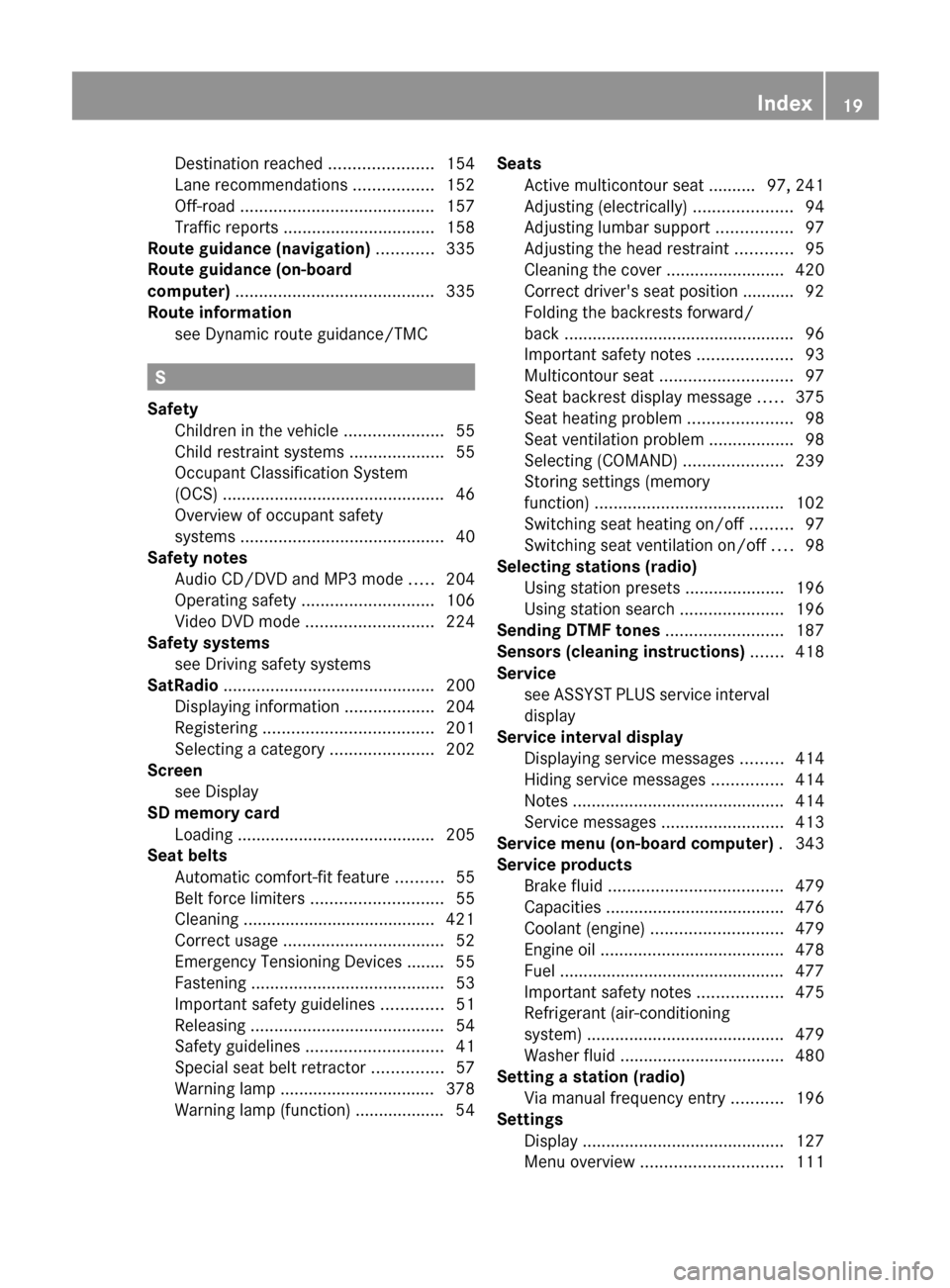
Destination reached ......................154
Lane recommendations .................152
Off-road ......................................... 157
Traffic reports ................................ 158
Route guidance (navigation) ............ 335
Route guidance (on-board
computer) .......................................... 335
Route information see Dynamic route guidance/TMC
S
Safety Children in the vehicle .....................55
Child restraint systems ....................55
Occupant Classification System
(OCS) ............................................... 46
Overview of occupant safety
systems ........................................... 40
Safety notes
Audio CD/DVD and MP3 mode .....204
Operating safety ............................ 106
Video DVD mode ........................... 224
Safety systems
see Driving safety systems
SatRadio ............................................. 200
Displaying information ...................204
Registering .................................... 201
Selecting a category ......................202
Screen
see Display
SD memory card
Loading .......................................... 205
Seat belts
Automatic comfort-fit feature ..........55
Belt force limiters ............................ 55
Cleaning ......................................... 421
Correct usage .................................. 52
Emergency Tensioning Devices ........ 55
Fastening ......................................... 53
Important safety guidelines .............51
Releasing ......................................... 54
Safety guidelines ............................. 41
Special seat belt retractor ...............57
Warning lamp ................................. 378
Warning lamp (function) ................... 54
Seats
Active multicontour seat .......... 97, 241
Adjusting (electrically) .....................94
Adjusting lumbar support ................97
Adjusting the head restraint ............95
Cleaning the cover .........................420
Correct driver's seat position ........... 92
Folding the backrests forward/
back ................................................. 96
Important safety notes ....................93
Multicontour seat ............................ 97
Seat backrest display message .....375
Seat heating problem ......................98
Seat ventilation problem ..................98
Selecting (COMAND) .....................239
Storing settings (memory
function) ........................................ 102
Switching seat heating on/off .........97
Switching seat ventilation on/off ....98
Selecting stations (radio)
Using station presets .....................196
Using station search ......................196
Sending DTMF tones ......................... 187
Sensors (cleaning instructions) ....... 418
Service see ASSYST PLUS service interval
display
Service interval display
Displaying service messages .........414
Hiding service messages ...............414
Notes ............................................. 414
Service messages ..........................413
Service menu (on-board computer) . 343
Service products Brake fluid ..................................... 479
Capacities ...................................... 476
Coolant (engine) ............................ 479
Engine oil ....................................... 478
Fuel ................................................ 477
Important safety notes ..................475
Refrigerant (air-conditioning
system) .......................................... 479
Washer fluid ................................... 480
Setting a station (radio)
Via manual frequency entry ...........196
Settings
Display ........................................... 127
Menu overview .............................. 111Index19
Page 42 of 488
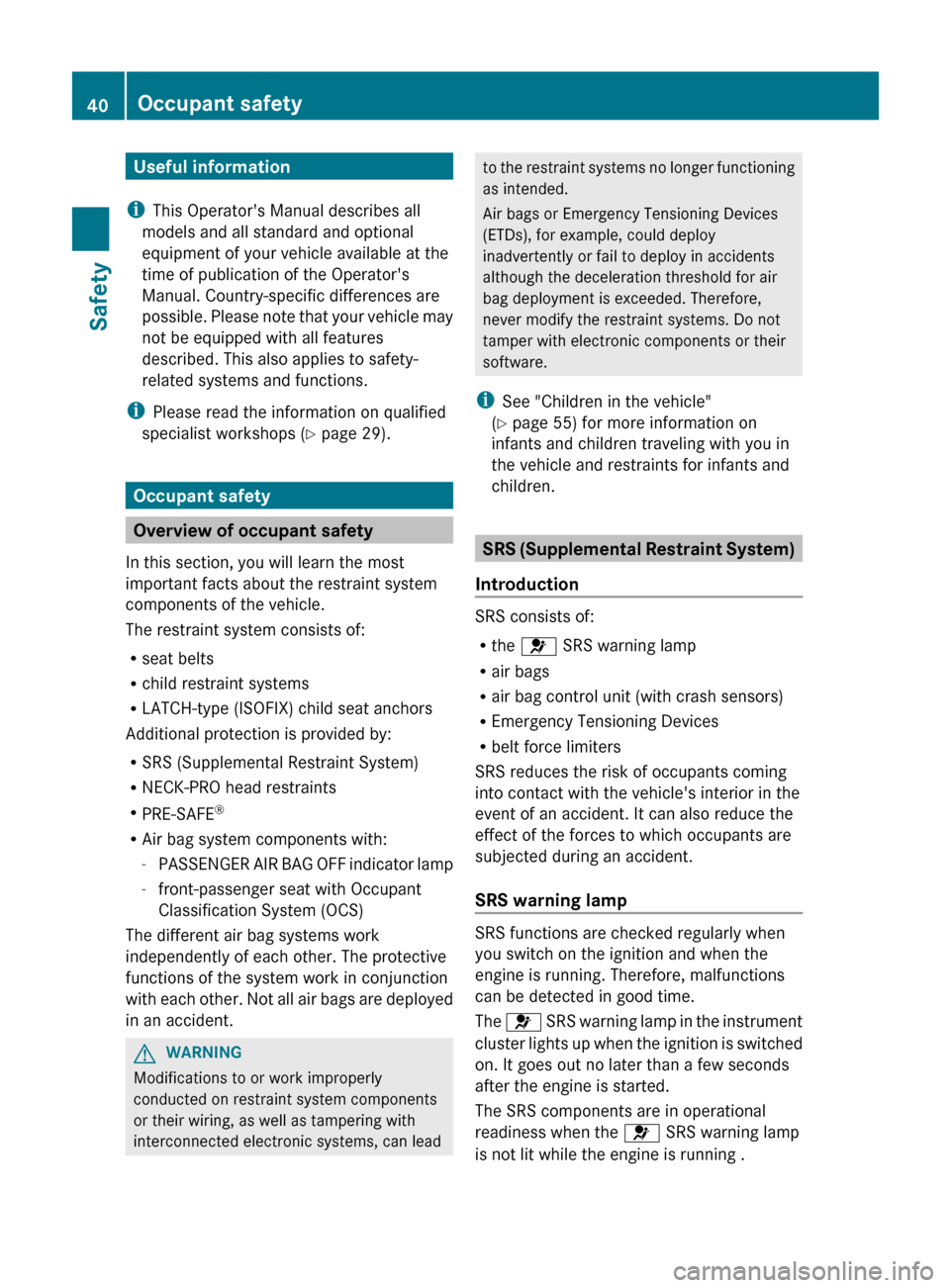
Useful information
i This Operator's Manual describes all
models and all standard and optional
equipment of your vehicle available at the
time of publication of the Operator's
Manual. Country-specific differences are
possible. Please note that your vehicle may
not be equipped with all features
described. This also applies to safety-
related systems and functions.
i Please read the information on qualified
specialist workshops ( Y page 29).
Occupant safety
Overview of occupant safety
In this section, you will learn the most
important facts about the restraint system
components of the vehicle.
The restraint system consists of:
R seat belts
R child restraint systems
R LATCH-type (ISOFIX) child seat anchors
Additional protection is provided by:
R SRS (Supplemental Restraint System)
R NECK-PRO head restraints
R PRE-SAFE ®
R Air bag system components with:
- PASSENGER AIR BAG OFF indicator lamp
- front-passenger seat with Occupant
Classification System (OCS)
The different air bag systems work
independently of each other. The protective
functions of the system work in conjunction
with each other. Not all air bags are deployed
in an accident.
GWARNING
Modifications to or work improperly
conducted on restraint system components
or their wiring, as well as tampering with
interconnected electronic systems, can lead
to the restraint systems no longer functioning
as intended.
Air bags or Emergency Tensioning Devices
(ETDs), for example, could deploy
inadvertently or fail to deploy in accidents
although the deceleration threshold for air
bag deployment is exceeded. Therefore,
never modify the restraint systems. Do not
tamper with electronic components or their
software.
i See "Children in the vehicle"
( Y page 55) for more information on
infants and children traveling with you in
the vehicle and restraints for infants and
children.
SRS (Supplemental Restraint System)
Introduction
SRS consists of:
R the 6 SRS warning lamp
R air bags
R air bag control unit (with crash sensors)
R Emergency Tensioning Devices
R belt force limiters
SRS reduces the risk of occupants coming
into contact with the vehicle's interior in the
event of an accident. It can also reduce the
effect of the forces to which occupants are
subjected during an accident.
SRS warning lamp
SRS functions are checked regularly when
you switch on the ignition and when the
engine is running. Therefore, malfunctions
can be detected in good time.
The 6 SRS warning lamp in the instrument
cluster lights up when the ignition is switched
on. It goes out no later than a few seconds
after the engine is started.
The SRS components are in operational
readiness when the 6 SRS warning lamp
is not lit while the engine is running .
40Occupant safetySafety
Page 46 of 488
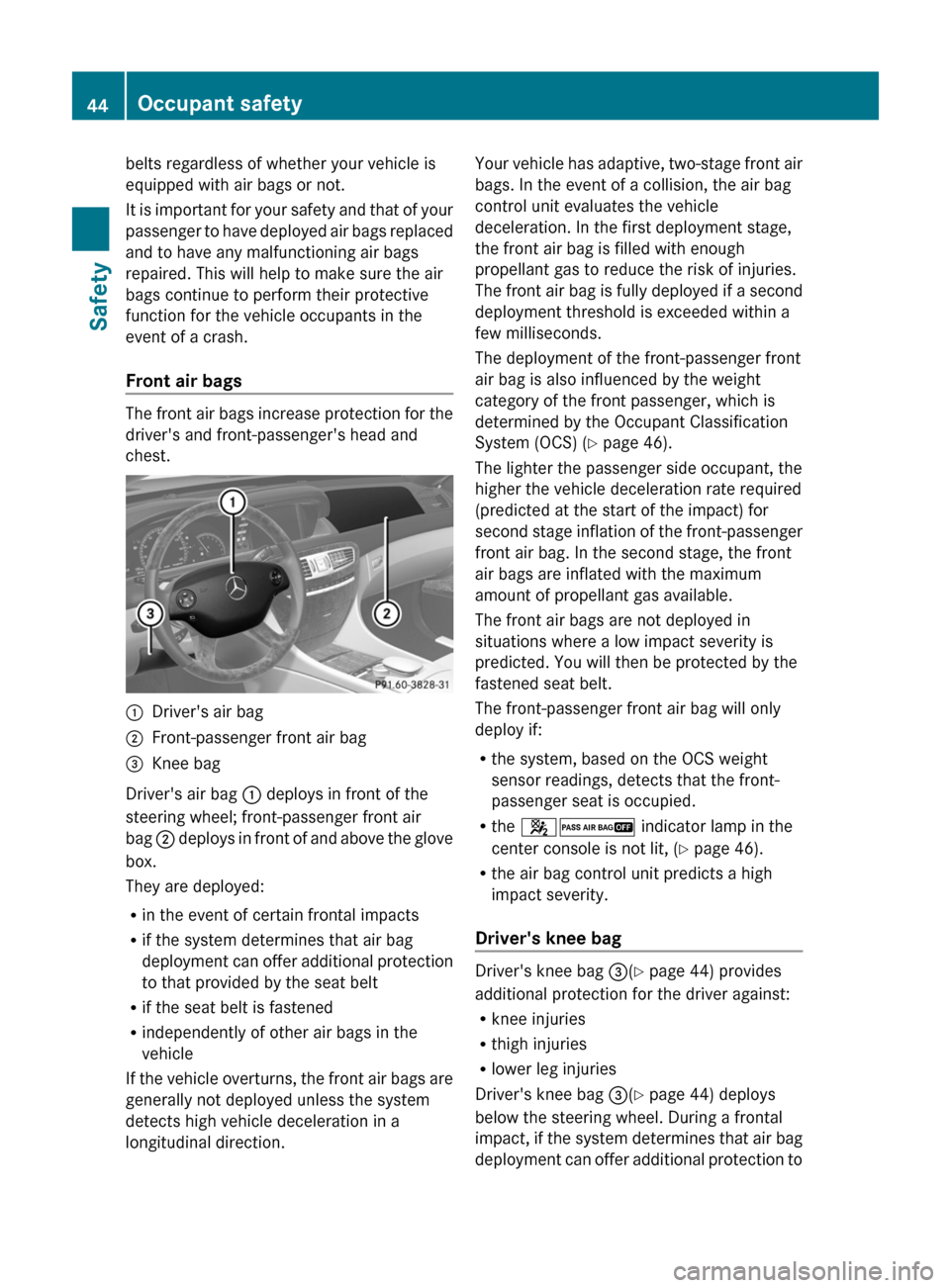
belts regardless of whether your vehicle is
equipped with air bags or not.
It is important for your safety and that of your
passenger to have deployed air bags replaced
and to have any malfunctioning air bags
repaired. This will help to make sure the air
bags continue to perform their protective
function for the vehicle occupants in the
event of a crash.
Front air bags
The front air bags increase protection for the
driver's and front-passenger's head and
chest.
:Driver's air bag;Front-passenger front air bag=Knee bag
Driver's air bag : deploys in front of the
steering wheel; front-passenger front air
bag ; deploys in front of and above the glove
box.
They are deployed:
R in the event of certain frontal impacts
R if the system determines that air bag
deployment can offer additional protection
to that provided by the seat belt
R if the seat belt is fastened
R independently of other air bags in the
vehicle
If the vehicle overturns, the front air bags are
generally not deployed unless the system
detects high vehicle deceleration in a
longitudinal direction.
Your vehicle has adaptive, two-stage front air
bags. In the event of a collision, the air bag
control unit evaluates the vehicle
deceleration. In the first deployment stage,
the front air bag is filled with enough
propellant gas to reduce the risk of injuries.
The front air bag is fully deployed if a second
deployment threshold is exceeded within a
few milliseconds.
The deployment of the front-passenger front
air bag is also influenced by the weight
category of the front passenger, which is
determined by the Occupant Classification
System (OCS) ( Y page 46).
The lighter the passenger side occupant, the
higher the vehicle deceleration rate required
(predicted at the start of the impact) for
second stage inflation of the front-passenger
front air bag. In the second stage, the front
air bags are inflated with the maximum
amount of propellant gas available.
The front air bags are not deployed in
situations where a low impact severity is
predicted. You will then be protected by the
fastened seat belt.
The front-passenger front air bag will only
deploy if:
R the system, based on the OCS weight
sensor readings, detects that the front-
passenger seat is occupied.
R the 42 indicator lamp in the
center console is not lit, ( Y page 46).
R the air bag control unit predicts a high
impact severity.
Driver's knee bag
Driver's knee bag =(Y page 44) provides
additional protection for the driver against:
R knee injuries
R thigh injuries
R lower leg injuries
Driver's knee bag =(Y page 44) deploys
below the steering wheel. During a frontal
impact, if the system determines that air bag
deployment can offer additional protection to
44Occupant safetySafety
Page 47 of 488
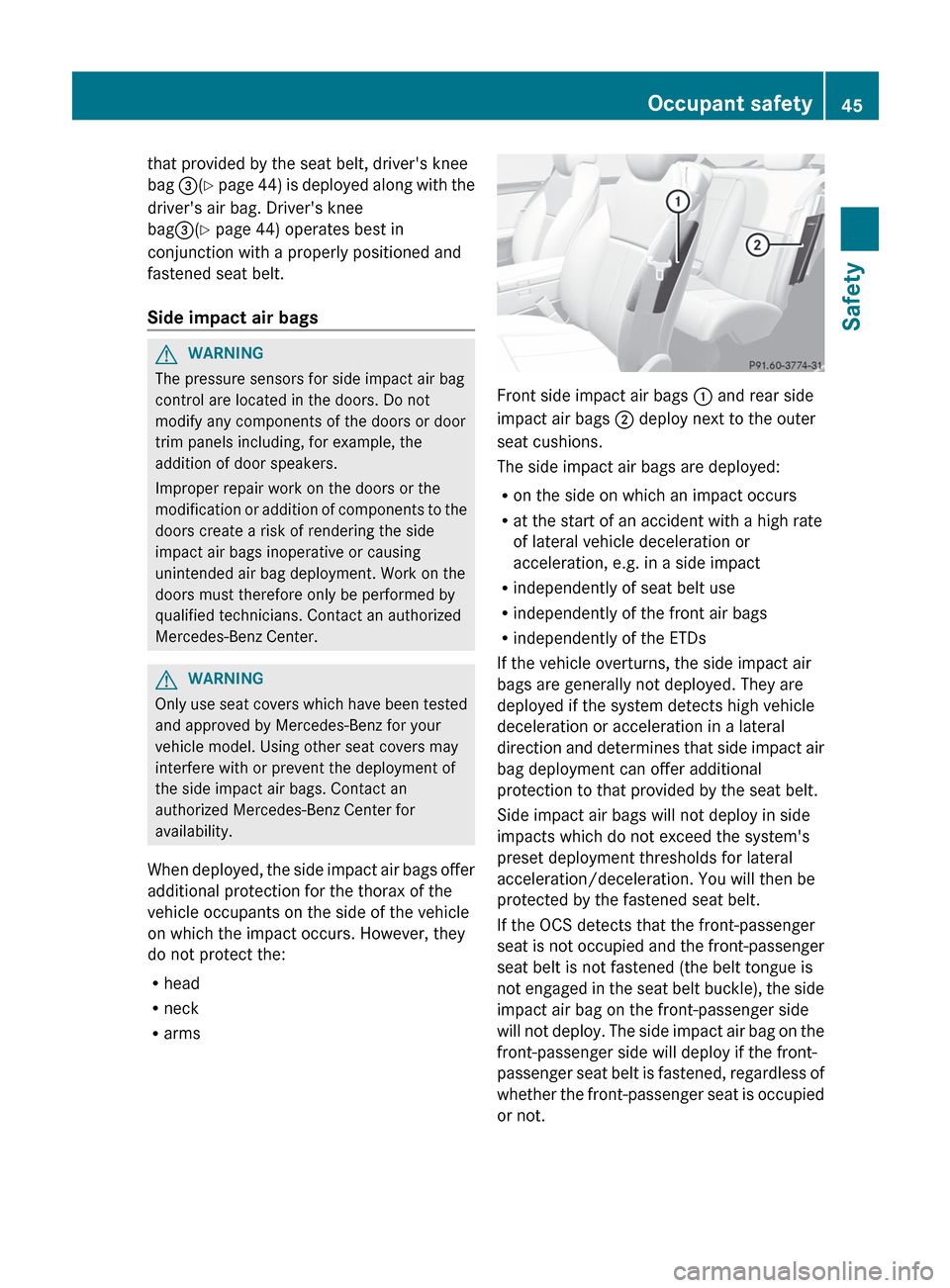
that provided by the seat belt, driver's knee
bag =(Y page 44) is deployed along with the
driver's air bag. Driver's knee
bag =(Y page 44) operates best in
conjunction with a properly positioned and
fastened seat belt.
Side impact air bagsGWARNING
The pressure sensors for side impact air bag
control are located in the doors. Do not
modify any components of the doors or door
trim panels including, for example, the
addition of door speakers.
Improper repair work on the doors or the
modification or addition of components to the
doors create a risk of rendering the side
impact air bags inoperative or causing
unintended air bag deployment. Work on the
doors must therefore only be performed by
qualified technicians. Contact an authorized
Mercedes-Benz Center.
GWARNING
Only use seat covers which have been tested
and approved by Mercedes-Benz for your
vehicle model. Using other seat covers may
interfere with or prevent the deployment of
the side impact air bags. Contact an
authorized Mercedes-Benz Center for
availability.
When deployed, the side impact air bags offer
additional protection for the thorax of the
vehicle occupants on the side of the vehicle
on which the impact occurs. However, they
do not protect the:
R head
R neck
R arms
Front side impact air bags : and rear side
impact air bags ; deploy next to the outer
seat cushions.
The side impact air bags are deployed:
R on the side on which an impact occurs
R at the start of an accident with a high rate
of lateral vehicle deceleration or
acceleration, e.g. in a side impact
R independently of seat belt use
R independently of the front air bags
R independently of the ETDs
If the vehicle overturns, the side impact air
bags are generally not deployed. They are
deployed if the system detects high vehicle
deceleration or acceleration in a lateral
direction and determines that side impact air
bag deployment can offer additional
protection to that provided by the seat belt.
Side impact air bags will not deploy in side
impacts which do not exceed the system's
preset deployment thresholds for lateral
acceleration/deceleration. You will then be
protected by the fastened seat belt.
If the OCS detects that the front-passenger
seat is not occupied and the front-passenger
seat belt is not fastened (the belt tongue is
not engaged in the seat belt buckle), the side
impact air bag on the front-passenger side
will not deploy. The side impact air bag on the
front-passenger side will deploy if the front-
passenger seat belt is fastened, regardless of
whether the front-passenger seat is occupied
or not.
Occupant safety45SafetyZ
Page 48 of 488
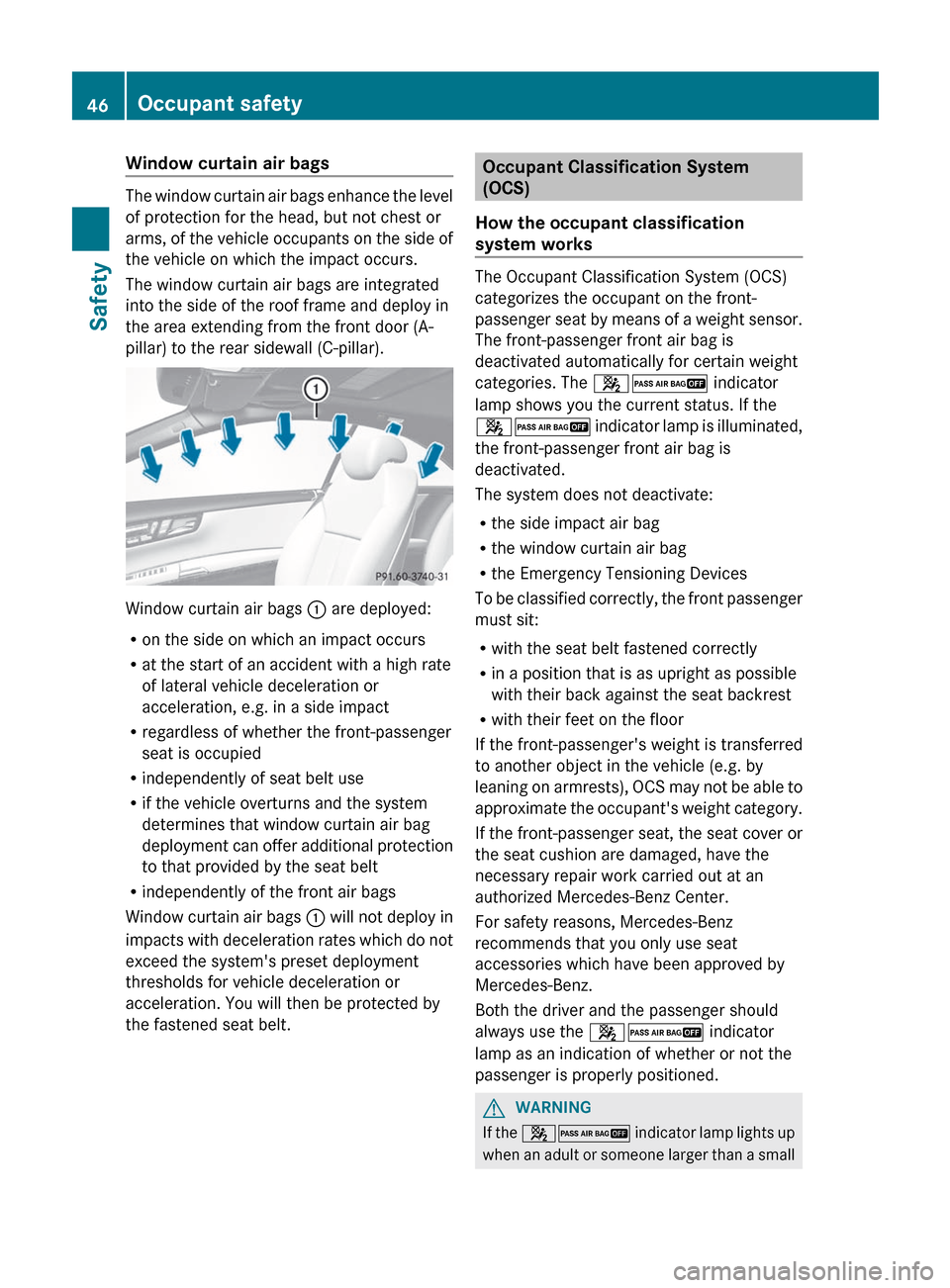
Window curtain air bags
The window curtain air bags enhance the level
of protection for the head, but not chest or
arms, of the vehicle occupants on the side of
the vehicle on which the impact occurs.
The window curtain air bags are integrated
into the side of the roof frame and deploy in
the area extending from the front door (A-
pillar) to the rear sidewall (C-pillar).
Window curtain air bags : are deployed:
R on the side on which an impact occurs
R at the start of an accident with a high rate
of lateral vehicle deceleration or
acceleration, e.g. in a side impact
R regardless of whether the front-passenger
seat is occupied
R independently of seat belt use
R if the vehicle overturns and the system
determines that window curtain air bag
deployment can offer additional protection
to that provided by the seat belt
R independently of the front air bags
Window curtain air bags : will not deploy in
impacts with deceleration rates which do not
exceed the system's preset deployment
thresholds for vehicle deceleration or
acceleration. You will then be protected by
the fastened seat belt.
Occupant Classification System
(OCS)
How the occupant classification
system works
The Occupant Classification System (OCS)
categorizes the occupant on the front-
passenger seat by means of a weight sensor.
The front-passenger front air bag is
deactivated automatically for certain weight
categories. The 42 indicator
lamp shows you the current status. If the
42 indicator lamp is illuminated,
the front-passenger front air bag is
deactivated.
The system does not deactivate:
R the side impact air bag
R the window curtain air bag
R the Emergency Tensioning Devices
To be classified correctly, the front passenger
must sit:
R with the seat belt fastened correctly
R in a position that is as upright as possible
with their back against the seat backrest
R with their feet on the floor
If the front-passenger's weight is transferred
to another object in the vehicle (e.g. by
leaning on armrests), OCS may not be able to
approximate the occupant's weight category.
If the front-passenger seat, the seat cover or
the seat cushion are damaged, have the
necessary repair work carried out at an
authorized Mercedes-Benz Center.
For safety reasons, Mercedes-Benz
recommends that you only use seat
accessories which have been approved by
Mercedes-Benz.
Both the driver and the passenger should
always use the 42 indicator
lamp as an indication of whether or not the
passenger is properly positioned.
GWARNING
If the 42 indicator lamp lights up
when an adult or someone larger than a small
46Occupant safetySafety
Page 49 of 488
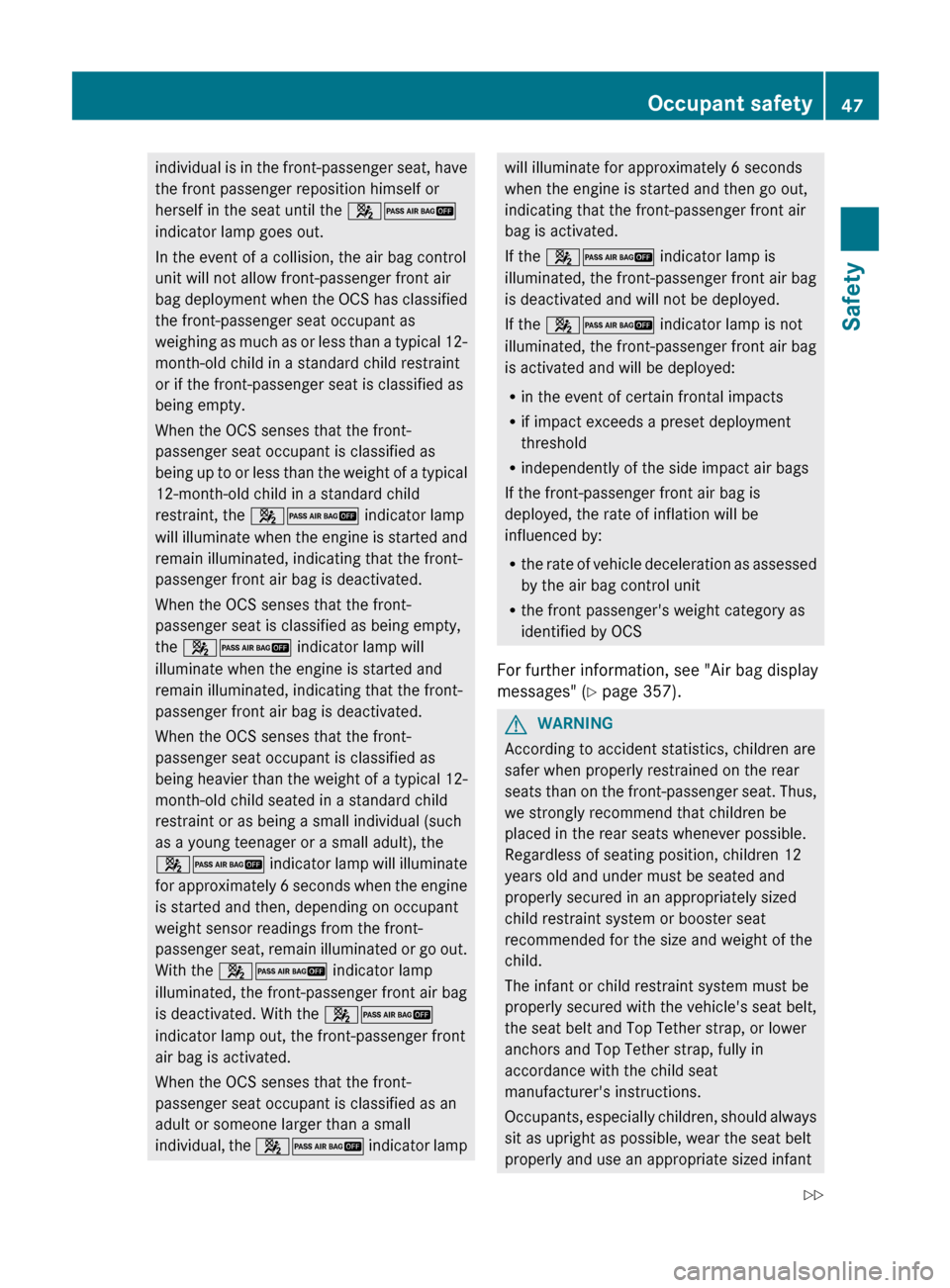
individual is in the front-passenger seat, have
the front passenger reposition himself or
herself in the seat until the 42
indicator lamp goes out.
In the event of a collision, the air bag control
unit will not allow front-passenger front air
bag deployment when the OCS has classified
the front-passenger seat occupant as
weighing as much as or less than a typical 12-
month-old child in a standard child restraint
or if the front-passenger seat is classified as
being empty.
When the OCS senses that the front-
passenger seat occupant is classified as
being up to or less than the weight of a typical
12-month-old child in a standard child
restraint, the 42 indicator lamp
will illuminate when the engine is started and
remain illuminated, indicating that the front-
passenger front air bag is deactivated.
When the OCS senses that the front-
passenger seat is classified as being empty,
the 42 indicator lamp will
illuminate when the engine is started and
remain illuminated, indicating that the front-
passenger front air bag is deactivated.
When the OCS senses that the front-
passenger seat occupant is classified as
being heavier than the weight of a typical 12-
month-old child seated in a standard child
restraint or as being a small individual (such
as a young teenager or a small adult), the
42 indicator lamp will illuminate
for approximately 6 seconds when the engine
is started and then, depending on occupant
weight sensor readings from the front-
passenger seat, remain illuminated or go out.
With the 42 indicator lamp
illuminated, the front-passenger front air bag
is deactivated. With the 42
indicator lamp out, the front-passenger front
air bag is activated.
When the OCS senses that the front-
passenger seat occupant is classified as an
adult or someone larger than a small
individual, the 42 indicator lampwill illuminate for approximately 6 seconds
when the engine is started and then go out,
indicating that the front-passenger front air
bag is activated.
If the 42 indicator lamp is
illuminated, the front-passenger front air bag
is deactivated and will not be deployed.
If the 42 indicator lamp is not
illuminated, the front-passenger front air bag
is activated and will be deployed:
R in the event of certain frontal impacts
R if impact exceeds a preset deployment
threshold
R independently of the side impact air bags
If the front-passenger front air bag is
deployed, the rate of inflation will be
influenced by:
R the rate of vehicle deceleration as assessed
by the air bag control unit
R the front passenger's weight category as
identified by OCS
For further information, see "Air bag display
messages" ( Y page 357).GWARNING
According to accident statistics, children are
safer when properly restrained on the rear
seats than on the front-passenger seat. Thus,
we strongly recommend that children be
placed in the rear seats whenever possible.
Regardless of seating position, children 12
years old and under must be seated and
properly secured in an appropriately sized
child restraint system or booster seat
recommended for the size and weight of the
child.
The infant or child restraint system must be
properly secured with the vehicle's seat belt,
the seat belt and Top Tether strap, or lower
anchors and Top Tether strap, fully in
accordance with the child seat
manufacturer's instructions.
Occupants, especially children, should always
sit as upright as possible, wear the seat belt
properly and use an appropriate sized infant
Occupant safety47SafetyZ